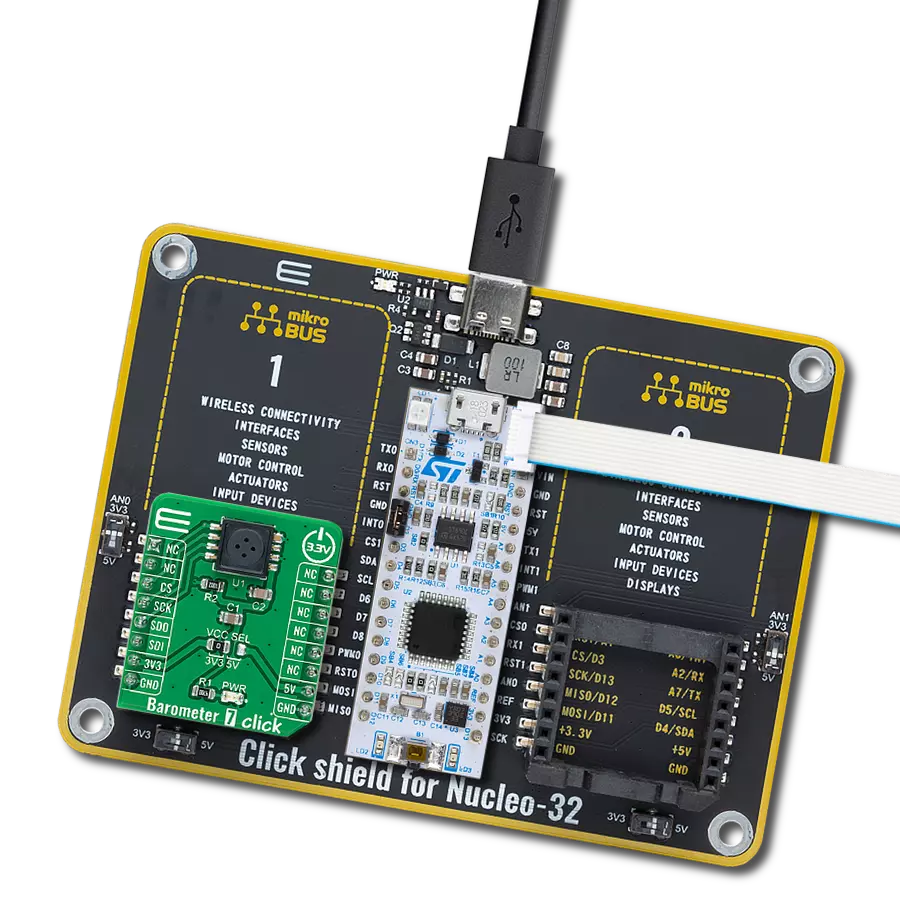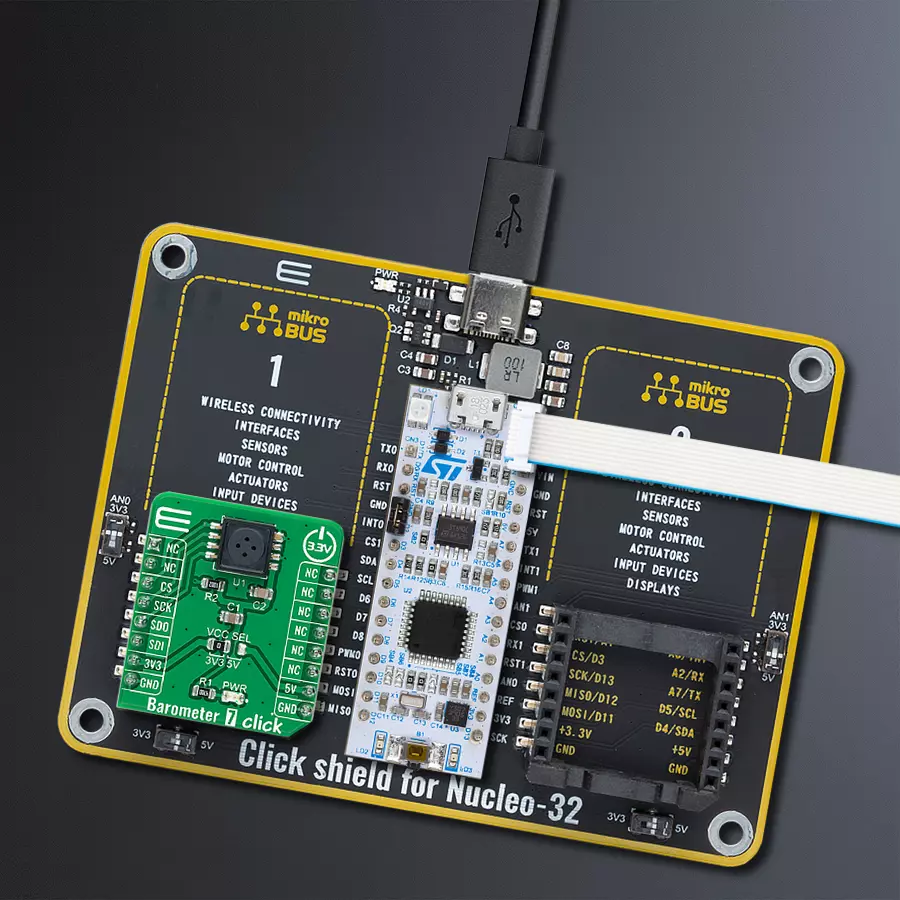Explore the significance of barometers as essential instruments in scientific research and experimentation
A
A
Hardware Overview
How does it work?
Barometer 7 Click is based on the KP264XTMA1, a high-accuracy digital barometric air pressure sensor from Infineon Technologies, to measure air pressure in a specific environment. The sensor is individually calibrated and temperature compensated, reducing software complexity by directly reading pressure and temperature. The KP264XTMA1 provides a fast startup time of less than 10ms measures pressure from 40kPa up to 115kPa with an accuracy of ±1.5kPa, ideally suited to the harsh environmental conditions prevalent in industrial and consumer applications. This Click
board™ communicates with MCU through a standard SPI interface that enables high clock speeds up to 5MHz. The KP264XTMA1 converts pressure into a 10-bit digital value and sends the information via the SPI interface. In addition, a temperature sensor is also integrated into this chip. Based on the received SPI command, the 10-bit temperature information will also be transmitted via the SPI interface. The KP264XTMA1 is fully calibrated and has a linear transfer function between the applied pressure and the digital output signal. Its unique reliability feature is the
integrated diagnostic mode, which tests the sensor cells and the signal path, triggered with an SPI command. This Click board™ can operate with either 3.3V or 5V logic voltage levels selected via the VCC SEL jumper. This way, both 3.3V and 5V capable MCUs can use the communication lines properly. Also, this Click board™ comes equipped with a library containing easy-to-use functions and an example code that can be used as a reference for further development.
Features overview
Development board
Nucleo 32 with STM32F031K6 MCU board provides an affordable and flexible platform for experimenting with STM32 microcontrollers in 32-pin packages. Featuring Arduino™ Nano connectivity, it allows easy expansion with specialized shields, while being mbed-enabled for seamless integration with online resources. The
board includes an on-board ST-LINK/V2-1 debugger/programmer, supporting USB reenumeration with three interfaces: Virtual Com port, mass storage, and debug port. It offers a flexible power supply through either USB VBUS or an external source. Additionally, it includes three LEDs (LD1 for USB communication, LD2 for power,
and LD3 as a user LED) and a reset push button. The STM32 Nucleo-32 board is supported by various Integrated Development Environments (IDEs) such as IAR™, Keil®, and GCC-based IDEs like AC6 SW4STM32, making it a versatile tool for developers.
Microcontroller Overview
MCU Card / MCU

Architecture
ARM Cortex-M0
MCU Memory (KB)
32
Silicon Vendor
STMicroelectronics
Pin count
32
RAM (Bytes)
4096
You complete me!
Accessories
Click Shield for Nucleo-32 is the perfect way to expand your development board's functionalities with STM32 Nucleo-32 pinout. The Click Shield for Nucleo-32 provides two mikroBUS™ sockets to add any functionality from our ever-growing range of Click boards™. We are fully stocked with everything, from sensors and WiFi transceivers to motor control and audio amplifiers. The Click Shield for Nucleo-32 is compatible with the STM32 Nucleo-32 board, providing an affordable and flexible way for users to try out new ideas and quickly create prototypes with any STM32 microcontrollers, choosing from the various combinations of performance, power consumption, and features. The STM32 Nucleo-32 boards do not require any separate probe as they integrate the ST-LINK/V2-1 debugger/programmer and come with the STM32 comprehensive software HAL library and various packaged software examples. This development platform provides users with an effortless and common way to combine the STM32 Nucleo-32 footprint compatible board with their favorite Click boards™ in their upcoming projects.
Used MCU Pins
mikroBUS™ mapper
Take a closer look
Click board™ Schematic

Step by step
Project assembly
Track your results in real time
Application Output
1. Application Output - In Debug mode, the 'Application Output' window enables real-time data monitoring, offering direct insight into execution results. Ensure proper data display by configuring the environment correctly using the provided tutorial.

2. UART Terminal - Use the UART Terminal to monitor data transmission via a USB to UART converter, allowing direct communication between the Click board™ and your development system. Configure the baud rate and other serial settings according to your project's requirements to ensure proper functionality. For step-by-step setup instructions, refer to the provided tutorial.

3. Plot Output - The Plot feature offers a powerful way to visualize real-time sensor data, enabling trend analysis, debugging, and comparison of multiple data points. To set it up correctly, follow the provided tutorial, which includes a step-by-step example of using the Plot feature to display Click board™ readings. To use the Plot feature in your code, use the function: plot(*insert_graph_name*, variable_name);. This is a general format, and it is up to the user to replace 'insert_graph_name' with the actual graph name and 'variable_name' with the parameter to be displayed.

Software Support
Library Description
This library contains API for Barometer 7 Click driver.
Key functions:
barometer7_get_pressure- Barometer 7 get pressure functionbarometer7_get_temperature- Barometer 7 get temperature function
Open Source
Code example
The complete application code and a ready-to-use project are available through the NECTO Studio Package Manager for direct installation in the NECTO Studio. The application code can also be found on the MIKROE GitHub account.
/*!
* @file main.c
* @brief Barometer7 Click example
*
* # Description
* This library contains API for Barometer 7 Click driver.
* The demo application reads and calculate temperature and pressure data.
*
* The demo application is composed of two sections :
*
* ## Application Init
* Initializes SPI driver and log UART.
* After driver initialization the app set default settings
* and display sensor identifier data.
*
* ## Application Task
* This is an example that demonstrates the use of the Barometer 7 Click board™.
* In this example, display the Pressure ( mBar ) and Temperature ( degree Celsius ) data.
* Results are being sent to the Usart Terminal where you can track their changes.
*
* ## Additional Function
* - static void display_error ( void )
*
* @author Nenad Filipovic
*
*/
#include "board.h"
#include "log.h"
#include "barometer7.h"
static barometer7_t barometer7;
static log_t logger;
static void display_error ( void )
{
if ( BAROMETER7_EEPROM_FEC_ERROR == barometer7.diagnosis )
{
log_printf( &logger, " EEPROM: FEC error\r\n" );
}
if ( BAROMETER7_ACQUISITION_CHAIN_FAILURE == barometer7.diagnosis )
{
log_printf( &logger, " Acquisition chain failure: Diag1\r\n" );
}
if ( BAROMETER7_SENSOR_CELL_FAILURE == barometer7.diagnosis )
{
log_printf( &logger, " Sensor cell failure: Diag2\r\n" );
}
if ( BAROMETER7_PRESSURE_OUT_OF_RANGE_HIGH == barometer7.diagnosis )
{
log_printf( &logger, " Pressure out of range: High\r\n" );
}
if ( BAROMETER7_PRESSURE_OUT_OF_RANGE_LOW == barometer7.diagnosis )
{
log_printf( &logger, " Pressure out of range: Low\r\n" );
}
}
void application_init ( void )
{
log_cfg_t log_cfg; /**< Logger config object. */
barometer7_cfg_t barometer7_cfg; /**< Click config object. */
/**
* Logger initialization.
* Default baud rate: 115200
* Default log level: LOG_LEVEL_DEBUG
* @note If USB_UART_RX and USB_UART_TX
* are defined as HAL_PIN_NC, you will
* need to define them manually for log to work.
* See @b LOG_MAP_USB_UART macro definition for detailed explanation.
*/
LOG_MAP_USB_UART( log_cfg );
log_init( &logger, &log_cfg );
log_info( &logger, " Application Init " );
// Click initialization.
barometer7_cfg_setup( &barometer7_cfg );
BAROMETER7_MAP_MIKROBUS( barometer7_cfg, MIKROBUS_1 );
if ( SPI_MASTER_ERROR == barometer7_init( &barometer7, &barometer7_cfg ) )
{
log_error( &logger, " Communication init." );
for ( ; ; );
}
BAROMETER7_SET_DATA_SAMPLE_EDGE;
if ( BAROMETER7_ERROR == barometer7_default_cfg ( &barometer7 ) )
{
log_error( &logger, " Default configuration." );
for ( ; ; );
}
log_info( &logger, " Application Task " );
Delay_ms ( 100 );;
static barometer7_identifier_t id_data;
barometer7_get_identifier ( &barometer7, &id_data );
log_printf( &logger, "--------------------------\r\n" );
log_printf( &logger, " > Supplier : %d <\r\n", ( uint16_t ) id_data.supplier );
log_printf( &logger, " > Silicon Version : %d <\r\n", ( uint16_t ) id_data.silicon_version );
log_printf( &logger, " > Metal Version : %d <\r\n", ( uint16_t ) id_data.metal_version );
log_printf( &logger, " > ASCI Name : %c <\r\n", id_data.asic_name );
log_printf( &logger, "--------------------------\r\n" );
Delay_ms ( 1000 );
}
void application_task ( void )
{
static float pressure;
static float temperature;
barometer7_get_pressure( &barometer7, &pressure );
if ( BAROMETER7_NO_ERROR != barometer7.diagnosis )
{
display_error( );
}
log_printf( &logger, " Pressure : %.0f mbar\r\n", pressure );
barometer7_get_temperature( &barometer7, &temperature );
if ( BAROMETER7_NO_ERROR != barometer7.diagnosis )
{
display_error( );
}
log_printf( &logger, " Temperature : %.2f C\r\n", temperature );
log_printf( &logger, "--------------------------\r\n" );
Delay_ms ( 1000 );
Delay_ms ( 1000 );
}
int main ( void )
{
/* Do not remove this line or clock might not be set correctly. */
#ifdef PREINIT_SUPPORTED
preinit();
#endif
application_init( );
for ( ; ; )
{
application_task( );
}
return 0;
}
// ------------------------------------------------------------------------ END




































